Computer- controlled excimer lasers can sculpt the cornea into a new shape. Several types of procedures use these lasers to correct your focusing problem.
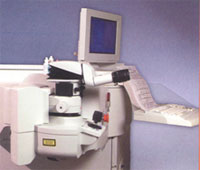
HIGH-tech SURGICAL TOOLS
A combination of high-tech tools is used to prepare and treat the cornea.
An excimer laser produces a concentrated beam of cool, ultraviolet (UV) light. Each pulse of this laser can remove a tiny portion of corneal tissue. An excimer laser is so accurate that it can cut a notch on a human hair. It generates no heat and is gentle to tissue.
An excimer laser is used to reshape the cornea.
These tools may be used to create a corneal flap:
• A microkeratome is a microsurgical instrument.
It can make extremely thin, precise cuts.
• A femtosecond laser produces rapid pulses of light. Like a microkeratome, it can make thin, precise cuts.
LASIK
LASIK (pronounced "LAY-sik") stands for laser in- situ keratomileusis. It’s a technique for reshaping corneal tissue. LASIK can be used to correct hyperopia, myopia, and astigmatism.
A flap is created in the stroma. The flap is folded back, remaining attached to the cornea.
Your surgeon uses a computer guided excimer laser to reshape the cornea.
The flap is put back into place. The corneal tissue sticks to itself while it heals.

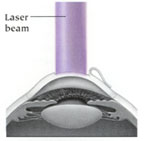
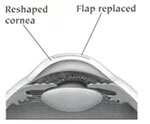
What to EXPECT
Before treatment, you may be given medication to help you relax. Eyedrops numb your eyes. A device is used to keep your eyes open. You may feel light pressure, but no pain, as your surgeon creates the flap. Laser treatment lasts for 10 to 90 seconds. After treatment, your vision will start to improve right away. It should become stable in 1 to 3 months.
What you should CONSIDER
Pros
• Little, if any, postoperative pain
• Fast recovery
• Very accurate, even for severe refractive problems
• Serious postoperative haze unlikely
• Structure of cornea remains intact
Cons
Risk of:
• Flap complications
• Infection or inflammation
• Blurred or distorted vision
• Temporary or permanent dry eye
• Night vision problems, such as halos, glare, or starbursts
• Undercorrection or overcorrection
• Loss of best corrected vision (vision not as good as that with glasses before surgery)
PRK
PRK (photorefractive keratectomy) is a procedure in which a laser is used to reshape corneal tissue. PRK can be used to treat low to moderate myopia, hyperopia, and astigmatism.
Your surgeon uses a computer guided excimer laser to reshape the cornea.
After laser treatment, you will wear a contact lens as a bandage for a few days. This protects the cornea as it heals.

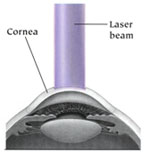
What to EXPECT
Before treatment, you may be given medication to help you relax. Eyedrops numb your eyes . A device is used to keep your eyes open. A small surgical tool or the laser is first used to remove the central portion of the epithelium. Laser treatment lasts for 10 to 90 seconds. For a few days after the procedure, your vision may seem worse. It should begin to improve in about 5 days, and become stable in about 6 months.
What you should CONSIDER
Pros
• No risk of flap complications
• Better for patients with thin corneas, previous glaucoma surgery, mild corneal scars, or other cornea problems.
Cons
• Mild to moderate pain after surgery
• Longer vision recovery than LASIK
• May need to use eyedrops for 3 months or longer.
Risk of:
• Corneal scarring or haze
• Temporary or permanent dry eye
• Night vision problems, such as halos, glare or starbursts.
• Undercorrection or overcorrection
• Loss of best corrected vision
LASEK
LASEK (pronounced" Lay-SEEK") stands for laser epithelial keratomileusis. With LASEK, the epithelium is softened with an alcohol solution to create a flap in the cornea. An excimer laser is used to reshape the underlying corneal tissue. LASEK can treat myopia, hyperopia, and astigmatism.
The epithelium is softened. It is then rolled back to expose the inner cornea tissue.
Your surgeon uses a computer – guided excimer laser to reshape the cornea.
The epithelium is folded back over the cornea. You will wear a contact lens as a bandage for a few days. This protects the cornea as it heals.
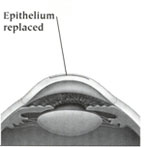
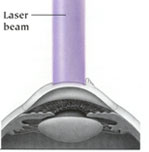
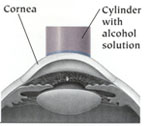
What to EXPECT
Before treatment, you may be given medication to help you relax. Eyedrops numb your eyes. A device is used to keep your eyes open. An instrument with alcohol solution in it is briefly placed on the cornea. The surgeon then rolls back the softened epithelium. Laser treatment lasts for 10 to 90 seconds. The epithelium is then put back into place. For a few days after the procedure, your vision may seem worse. It should begin to improve in about 5 days, and become stable in about 6 months.
What you should CONSIDER
Pros
• Better for patients with thin corneas, previous glaucoma surgery, mild corneal scars, or other cornea problems
• Possibly less postoperative discomfort, haze, regression, or corneal scarring than with PRK
• Possibly faster vision recovery than with PRK
Cons
• Mild to moderate pain after surgery
• Longer vision recovery than LASIK
• May need to use eyedrops for 3 months or longer
Risk of:
• Corneal scarring or haze
• Temporary or permanent dry eye
• Night vision problems, such as halos, glare, or starbursts
• Undercorrection or overcorrection
• Loss of best corrected vision
